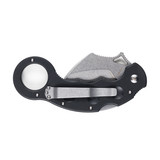HISTORY OF THE KARAMBIT

The Karambit can be traced from Sumatra to Malaysia and Java. The Karambit of Lombok (the island found between Bali and East Java – specifically the island of Sumbawa) is traditionally a larger or “battlefield-sized” karambit and is much larger than its more personal-sized Javanese cousin. Another variation of the Karambit comes from Madura Island (located Northeast of Java), which is more curved, known as the Clurit. There are also many different shapes and designs of the combat Karambit, such as Rajawali (bird head shape) and others, including protruding spurs used for tearing flesh in the heat of battle. Today, these features have been reduced to merely fanciful designs and, in most cases, ceremonious etchings.
The combination of the original design of the tiger’s claw combined with the hand weapons of the ancient characters of the Mahabharata and the Ramayana– the Kuku Macan, Kuku Bima, or Kuku Hanuman has evolved into what is known in modern times as the Karambit. It is now recognized internationally as a traditional Malay weapon.
Normally, in ancient times, when a fighter unsheathed a battlefield Karambit, the cutting edge was almost always smeared with some deadly poison that instantly acted upon entry into the bloodstream via laceration of the flesh. Even the smallest cut was enough to get the poison into the bloodstream. Knowledge and use of poisons derived from various species of poisonous frogs, snakes, scorpions, and spiders were considered essential to a warrior’s arsenal of close-quarter combative skills. These poisons rapidly accelerated death and were most feared for their nearly instantaneous killing power.
The personal Karambit (a smaller version of the battlefield Karambit) was primarily designed to target nerves and joints. As a result of such a small cutting surface, most cuts cannot be made deep enough to kill someone. That is why the karambit can be considered a personal self-defense tool. In contrast, the blade of the Karambit Besar (a larger or battlefield version of the personal-sized Karambit) is longer and thus permits deeper cuts. According to the ancients, the battlefield Karambit was preferred for its superior length and because you could, due to the lengthy cutting edge, “spill the entrails of your enemies onto the ground.” However, as in the West, with the advent of battle-worthy and functional firearms, bladed weapons became obsolete on the battlefield and relegated to the utilitarian uses of knives that we see today.
Often used as a last line of defense in ancient times when the larger Clurit was made inoperable, the smaller personal Karambit targets included the eyes, testicles, the Achilles tendon, carotid artery, biceps, forearm, and wrist. A particularly nasty target of ancient times was the clavicle (collarbone). Executed perfectly, the Karambit would catch the collarbone (tip pointed down) and is then quickly turned from palm down to palm up position, which would snap the bone using your body weight, thus rendering your enemy’s weapon arm useless.
Specifically designed as a close-quarter self-defense weapon, the Karambit of old was additionally quite difficult to see in the hand due to its method of deployment and cover of the fingers. Doubly menacing was that it could not be disarmed due to its forefinger grip design. It was unique to any other blade at the time as it could be used for both medium and close fighting ranges without changing the distance of the striking arm. It was also the only blade used in battle that could cut twice with a single arm stroke. All other blades of that era need one motion for one cut. The ancient battlefield Karambit was unique because:
- It could not be easily seen.
- It could not be effectively disarmed
- It could change ranges without body movement
- It could deliver two strikes in a single-arm motion.
- It could be held in three completely different grip configurations
- It could be used simultaneously with other weapons systems
In 21st Century America, the Karambit has found a home with campers, hunters, martial artists, collectors, knife enthusiasts, and defense-minded citizens who choose to carry a utility knife that can also be used in the event of an assault on their person. As with any tool of value, it becomes the responsibility of its owner to know how to care for and safely operate it.
In the “blade cultures” of the Malay people, such a utility tool (that could also be used for personal protection) represents skill, maturity, honor, and wisdom. Those well versed in its usage have a greater advantage than those without. An ancient code of ethics reminds the practitioner that his knife should not be unsheathed without good reason or without honor.

